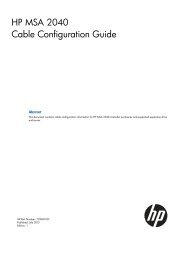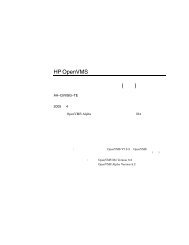HP ProCurve Wireless Access Point 420 - Hewlett Packard
HP ProCurve Wireless Access Point 420 - Hewlett Packard
HP ProCurve Wireless Access Point 420 - Hewlett Packard
Create successful ePaper yourself
Turn your PDF publications into a flip-book with our unique Google optimized e-Paper software.
Configuring <strong>Wireless</strong> Security<br />
<strong>Access</strong> <strong>Point</strong> Configuration<br />
Configuring <strong>Wireless</strong> Security<br />
The access point is configured by default as an “open system,” which broadcasts<br />
a beacon signal including the configured SSID. <strong>Wireless</strong> clients can read<br />
the SSID from the beacon, and automatically reset their SSID to allow immediate<br />
connection to the nearest access point.<br />
To improve wireless network security, you have to implement two main<br />
functions:<br />
■ Authentication: It must be verified that clients attempting to connect to<br />
the network are authorized users.<br />
■ Traffic Encryption: Data passing between the access point and clients<br />
must be protected from interception and eves dropping.<br />
For a more secure network, the access point can implement one or a combination<br />
of the following security mechanisms:<br />
■ Wired Equivalent Privacy (WEP)<br />
■ IEEE 802.1x<br />
■ <strong>Wireless</strong> MAC address filtering<br />
■ Wi-Fi Protected <strong>Access</strong> (WPA)<br />
The security mechanisms that may be employed depend on the level of<br />
security required, the network and management resources available, and the<br />
software support provided on wireless clients.<br />
Wired Equivalent Privacy (WEP) . WEP provides a basic level of security,<br />
preventing unauthorized access to the network and encrypting data transmitted<br />
between wireless clients and the access point. WEP uses static shared<br />
keys (fixed-length hexadecimal or alphanumeric strings) that are manually<br />
distributed to all clients that want to use the network.<br />
WEP is the security protocol initially specified in the IEEE 802.11 standard<br />
for wireless communications. Unfortunately, WEP has been found to be<br />
seriously flawed and cannot be recommended for a high level of network<br />
security. For more robust wireless security, the access point provides Wi-Fi<br />
Protected <strong>Access</strong> (WPA) for improved data encryption and user authentication.<br />
IEEE 802.1x Network <strong>Access</strong> Control. IEEE 802.1x is a standard framework<br />
for network access control that uses a central RADIUS server for user<br />
authentication. This control feature prevents unauthorized access to the<br />
5-45

















